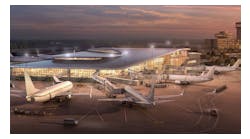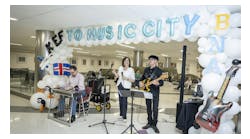Fresno Yosemite International Airport already has a new $29 million parking garage that opened last fall with more than 900 parking stalls directly across an access road from the terminal building.
Now airport officials are getting ready to embark on the next stage of what they call “FATforward,” an ambitious program of expansion and modernization of the terminal itself, as well as other important components of the airport.
The Fresno City Council recently approved a $10.1 million construction contract with Teichert Construction of Fresno for re-configuring and extending the apron or tarmac immediately east of the existing terminal building. That work, to be completed by the spring of 2023, will in turn set the stage for expanding the terminal itself by the end of 2024 – a project expected to cost about $120 million.
After that, there are plans for replacing the airport’s aging air traffic control tower and rebuilding one of the airport’s two runways.
The FATforward project name is a nod to the Federal Aviation Administration’s official airport code for Fresno Air Terminal, even as the rest of the city’s marketing embraces the Fresno Yosemite International moniker.
It all comes as Fresno Yosemite International sees its passenger volumes rebounding to record-setting levels after airline travel cratered in 2020 because of the global COVID-19 pandemic. By the end of this year, the airport forecasts that passenger boardings for airline flights – domestic and international – will approach 1.2 million. That compares to the pre-pandemic record of almost 965,000 passengers in 2019, and about 958,000 in 2021.
Future growth is expected to push the annual passenger figures to more than 1.4 million by 2030.
“We’re seeing unprecedented growth at our airport,” said Henry Thompson, the city of Fresno’s director of aviation. “It’s not just unprecedented; it’s bucking the trend for airports. … The level of growth that we’re seeing is outpacing other small airports and some large airports as well.”
The gears began turning on the parking garage and expansion program prior to the coronavirus pandemic, and well before Thompson started the job in late 2021, as airport officials realized the need to get ahead of the pace of growth.
The City Council awarded a first-phase contract of more than $8.8 million in March 2020 with Q&D Construction, a company based in Sparks, Nevada, for the initial design and pre-construction work for the terminal expansion. Airport officials said the City Council will be asked to approve moving forward with phase 2, the actual construction, later this year. That would be followed by a formal groundbreaking.
What will it mean for customers?
Work to enlarging the apron or tarmac will likely begin in September and take several months to complete. “It’s essentially a $12 million aircraft parking ramp,” Thompson said. The ramp is not, strictly speaking, part of the larger FATforward program, but is a necessary enabling step for the coming terminal expansion.
The first stages of construction for the terminal itself are expected to start later this year, and involve enlarging the security checkpoint used by U.S. Transportation Security Administration officers to screen passengers and carry-on bags.
“That’s really going to improve the customer experience because now during some periods, especially the morning hours, those lines can get pretty long out there,” Thompson said. “We’re addressing that by providing some additional capacity for TSA to be able to get our customers through more quickly.”
Passengers are unlikely to notice any major differences because the construction work will be screened from view by a temporary wall.
In another part of the airport, work will begin on enlarging and updating the machinery used to screen checked luggage – a behind-the-scenes process that also won’t be evident to passengers, “but it’s important from a security perspective,” Thompson said. The new X-ray technology will be able to “see” more deeply into suitcases and luggage, and “it’s probably going to require fewer bags to be physically opened” for inspection, he added.
The baggage inspection system is being designed and constructed to the TSA’s specifications, and Thompson said the federal agency is paying for that to the tune of about $24 million through a direct grant to the airport.
The larger TSA checkpoint and modernized luggage screening “are two important phases because when we get the terminal expansion completed, all of the infrastructure is in place and ready to support the additional traffic.”
Other, more publicly visible components of the project include a new upper-level concourse with two new jet bridge gates that can be used for both domestic and international arrivals; and a newer, bigger arrival and customs inspection area for international arrivals.
Thompson said the current Customs area for arriving international passengers can only process about 150 passengers per hour. The expansion, he said, will increase that capacity to about 400 passengers per hour.
The added concourse, gates and Customs inspection area “are going to offer us the ability to handle more international flights,” Thompson said. “It’s also going to offer the opportunity to potentially shift some of those international arrivals to earlier parts of the day. … We might see some late afternoon or early evening arrivals” instead of the current late-night times for flights by Aeromexico or Volaris, the two airlines that provide nonstop international service to cities in Mexico.
The modern design of the new terminal areas will be matched with a broader refresh of existing parts of the airport. “When our new expanded concourse opens, the existing terminal will have a lot of the similar finishes,” Thompson said. “You don’t want to have one side that’s 20 years old. … Everyone’s going to have the same experience.”
New concepts for airport concessions, including restaurants, food/beverage vendors and retail, will also be introduced as part of the overhaul. “We want customers to have a much improved and consistent experience throughout the airport,” Thompson said. “That’s better service, better offerings, similar to the experience they have at larger airports.”
Beyond the terminal building
The original vision for FATforward included the new garage and expanded terminal facilities, but there are other airport needs that are now being included in the overall program, including replacing the existing air traffic control tower and rebuilding the primary runway.
“The current FAA tower just turned 60 years old,” Thompson said. “It doesn’t quite meet current FAA standards, and it’s very difficult to maintain,” Thompson told The Fresno Bee. “Because it doesn’t meet current standards, current building codes, it’s not just a remodel. It’s a replacement.”
The cost to build a new tower, after which the old one will be retired, is estimated at about $30 million, and Thompson said the airport will be seeking federal funds to pay for it. Construction could begin as soon as 2024.
The airport’s 1.8-mile-long primary runway, Runway 11L/29R, is also in line for getting rebuilt, possibly within the next three to five years.
Between the commercial airliners, cargo jets and military Air National Guard aircraft that take off and land every day, “all of that does serious wear and tear on the runway,” Thompson said. “The pavement is coming toward the end of its life. It’s beyond where you can do a mid-life overlay; it needs significantly more work.”
Decisions on how to move forward remain, including whether to use asphalt or concrete. Concrete, Thompson said, costs more, but has a longer life span and is better able to stand up to wear and tear as well as fluids that can leak from aircraft.
While the main runway undergoes its reconstruction, all aircraft would be moved over to the secondary runway, which takes far less of a beating under current traffic conditions.
Costs creep higher
Over the past two years, the anticipated costs for the overall FATforward program and associated improvements have increased as the scope has grown, from a project budget reported in March 2020 by now-retired aviation director Kevin Meikle at $87.2 million for the terminal expansion to approximately $120 million now.
“We’re estimating $120 million, all in, with the baggage inspection system, the new federal inspection area and gates, the concourse, the expanded security checkpoint,” Thompson said. The estimate does not include additional money that will be needed for art components for the terminal, according to an Aug. 11 report to the Fresno City Council.
The new airport ramp for the expanded terminal is another $12 million. The new air traffic control tower has a preliminary estimate of $30 million, and rebuilding Runway 11L/29R may cost as much as $45 million.
Future phases, to be considered as passenger volume increases, include another new parking garage, additional arrival/departure gates, expanding the baggage claim area, and increasing capacity in the ticketing lobby with technology for people to drop off their own bags and more use of self-service check-in kiosks as well as physically expanding the lobby.
Because the city-owned airport is an enterprise department – a self-sustaining department that relies on rents and fees paid by airlines and companies using the facility as well as various transportation and federal aviation improvement grants – it does not receive any contributions from the city of Fresno’s general fund.
©2022 The Fresno Bee. Visit fresnobee.com. Distributed by Tribune Content Agency, LLC.


